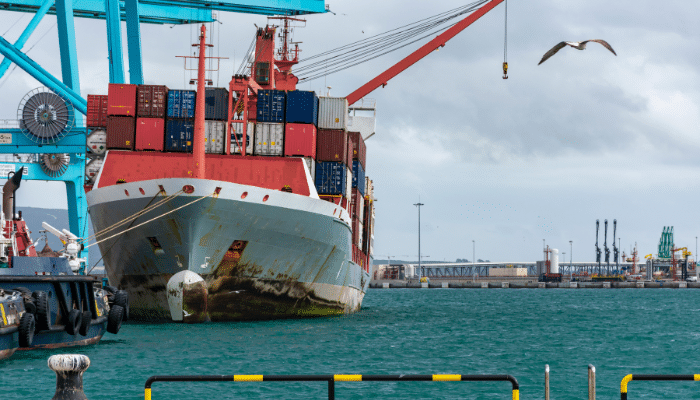Commoditisation of Container Shipping: Implications for Carriers and Cargo owners
In a previous article, we explored the trend of commoditisation of container shipping services and understood the reasons driving this trend.
In this article, we will delve into the implications of commoditisation for various stakeholders and the deleterious impact thereof on carriers and cargo owners.
To fully appreciate the commercial impact and implications of the trend of commoditisation, it is first necessary to distinguish between the commoditisation of shipping services and the commoditisation of freight.
The commoditisation of freight started quite a while before the commoditisation of shipping services. While both have had an adverse effect on the revenues of container carriers, the phenomena are different in their nature, how they unfolded, and the extent to which they can be controlled or reversed.

Commoditisation of freight was, in a way, an inevitable outcome of the introduction of containerised shipping services. Traditionally, while transporting freight, the value of the commodity played a role in determining freight rates, with high-value cargo being charged higher and vice versa (so the higher the cargo value, the higher the freight rate).
Container carriers would set different rates for different classes of commodities. While reefer or special cargo (that requires temperature-controlled transport or special handling during transit) obviously commanded a freight premium as compared to dry cargo transported in general containers, carriers would previously also further segregate dry cargo based on the nature and value of the commodity.
This meant that carriers quoted separate rates for cargo such as electronic goods, furniture, and household goods. On top of this, for low-value or mixed cargo, carriers also offered special FAK (Freight All Kind) rates. The intent was to entice shippers of low-value or mixed cargo to ship with that particular carrier by offering relatively better rates.
Besides the value, other factors determining the freight rates included the weight of the cargo, packaging requirements, etc.
Note on the correlation between weight of cargo and freight rates: When it comes to weight, the lighter the cargo, the lower the freight rate the carrier can offer.
This is because while determining the carrying capacity of a vessel, carriers calculate the nominal capacity in TEUs by assuming a per-container weight of approximately 14 tons when, in fact, a container can easily carry 20 tons (or more).
What this means is that for every tonne that the container exceeds the benchmark of 14 tons by, there is a corresponding reduction in the actual carrying capacity of the vessel – resulting in a lesser number of containers that can be loaded on the vessel and thus resulting in lower aggregate revenues.
To take an example, a 10,000 TEU vessel can carry a total weight of 140,000 tons (based on the standard of 14 tons per container). Now, if the average weight per container were actually found to be 21 tons, it would imply a significant reduction in the actual carrying capacity of the vessel.
In this particular instance, an increase of 50% in the average container weight would translate into a 33% reduction in the number of containers that can be loaded on the vessel.
Conversely, suppose the weight of a container is lower than 14 tons. In that case, the carrier has the option of accepting other cargo whose weight per container exceeds 14 tons, thus enabling the carrier to optimise its capacity utilisation and maximise revenues.
Now, while this is a very simplistic example, and it is extremely unlikely that the weight of all containers would be so high, it serves to illustrate how important it is for the Carrier to try to ensure a lower average container weight.
Carriers, therefore, would tend to quote higher freight rates for heavier cargo and offer lower rates for lighter cargo, sometimes going to the extent of imposing a Heavy Weight or Overweight surcharge.
This cargo-based pricing policy was carried forward even after containerised transport started gaining popularity.
As the rate of commoditisation improved rapidly, with more and more commodities starting to be transported in containers and container shipping becoming among the more prevalent modes of shipping, competition intensified with the advent of more players in the sector.
As more capacity was infused in the market, the competitive pressures resulting from the imbalance of supply and demand compelled container carriers to play with prices in order to retain business or increase market share.
This demand-supply mismatch amidst the influx of tonnage also meant that the potential opportunity loss that could arise from carrying heavier containers was minimised (since carriers now had surplus capacity anyway, it wasn’t as if they would have to refuse business simply because some cargo booked was heavier).
Carriers, therefore, started lowering the differential for heavier and high-value cargo. This meant that the premium that carriers were charging previously slowly started eroding, and the range of freight rates offered for different cargo types started getting narrower, resulting in lesser freight differentiation based on commodity type.
The situation slowly degenerated into one where the freight rate differential started diminishing and was altogether negated over a period of time. Today, freight rates offered are generally not very sensitive to commodity type (except in certain cases)
This is what is referred to as the commoditisation of freight.

Commoditisation of container shipping, on the other hand, refers to the phenomenon of growing standardisation of shipping services offered by container carriers, with nary a differentiating trait.
While the trend of commoditisation of freight was to a certain extent inevitable and the direct consequence of containerisation (as the whole intent of carrying cargo in containers was to standardise the transport process by having the container as a single and homogenous unit of transport, as opposed to previously, when cargo was packed in pallets and packages of various types, shapes and sizes, which by default eliminated the need for differentiated handling and storage requirements for diverse types of cargo and thus introduced an element of uniformity), the commoditisation of container shipping services is primarily ascribable to the consistent and widening demand-supply imbalance and the resultant competitive pressures on industry participants to increase utilisation levels (and thus ensure maximum utilisation and turnover of expensive assets such as vessels and containers – to recoup their ROI), even if it implied dropping rates and operating on wafer-thin margins.
Further, while the commoditisation of freight is, to a great extent, irreversible given the operating dynamics of the industry when it comes to the commoditisation of container shipping services, there are still ways in which container carriers can try to differentiate their products and attempt to stand out from the competition, by convincing customers to evaluate shipping services on parameters other than price.
In this article, we will understand the implications of commoditisation and understand why commoditised markets cause differentiated service offerings to fail.
Implications of Commoditisation:
Pressure on freight rates and Carrier’s profit margins
Commoditisation is both the result of and the source of price pressures exerted by the gap between supply and demand. Commoditisation initially began because carriers had to undercut prices in order to fill incremental tonnage being injected into the market. In contrast, competitors had to follow suit to avoid losing market share.
This levelling of price levels compelled carriers offering superior services to eliminate the differentiating elements of their services and instead mirror the service levels provided by competitors, which resulted in industry-wide standardisation.
As the services provided by all carriers were now highly similar, they were constrained to compete on prices and tried to lure customers by lowering freight rates further and further (in the absence of any other product/ service-based differentiator).
This gave rise to a self-perpetuating cycle wherein lower prices drove more standardisation, which in turn increased the pressure on freight rates and margins.
Deterioration in average operational service levels
Since the intense competition in the market and the supply-demand imbalance rendered rates the primary parameter in the selection of a container carrier, carriers were compelled to reduce rates to match the competition.
This included even carriers who earlier had a reputation for offering superior services and charged (and successfully obtained) a premium therefor. Since carriers were now constrained to quote rates in line with the prevailing market rates, they also started offering services which were aligned with what most competitors were offering.
This gradually led to a situation where all Carriers were offering services that were more or less uniform, just as their freight rates were. This meant that Carriers moved away from offering premium services, which competitors could not or would not provide, and instead matched the competitors’ service levels and pricing points.
This led to a decline in the average quality of services offered by the industry as a whole, as carriers slowly removed those service elements which customers were unwilling to pay for or whose value was not apparent to the customer.
Greater probability of Price wars
Since carriers were now competing on price and had deprioritised efforts to differentiate their service offerings, the inevitable result was price wars, as each carrier who wanted to gain market share or ensure maximum utilisation for their vessels had to undercut competition in the absence of other unique value propositions.
The downside was that such attempts by one carrier were immediately followed by corresponding rate cuts by other carriers, thus degenerating into all-out price wars.
With the growing pace of commoditisation and equipped with burgeoning war chests accumulated during the pandemic-fuelled freight boom, the probability of the industry witnessing price wars of greater intensity will only increase in the forthcoming years, especially considering the massive influx of capacity that is expected to hit the waters over the next 3 years.
Customers deprived of choices in terms of product offerings and alternate routings
Customer requirements for container shipping services vary considerably, depending on factors such as the size of the customers operations, volumes transported, geographical dispersion, nature and value of commodity, special handling requirements, lead time requirements, the criticality of cargo for upstream and downstream operations, seasonality, etc.
Therefore, customers often need services that are faster or more reliable or offer space guarantees to ensure that their supply chains and businesses operate smoothly. Depending on the situation, shippers often prefer premium services, where the potential incremental revenue will justify the premium freight rates charged.
Customers thus have the option of choosing between average service levels, which are prevalent in the market, or a premium service, which lends their supply chains a certain competitive edge, and they generally strive to strike a balance between premium and standard services.
With commoditisation and the reduction in premium services however, customers are deprived of this choice and have to select from amongst services which are highly uniform.
This implies that even in cases where the customer is willing to pay a premium for services of superior quality, it is quite probable that they will not find suitable options in the market and, therefore, will be forced to rely on the standard services available, which in turn implies that they will have to re-plan their supply chains and inventory management policies.
This usually necessitates building in some slack in their supply chain (to account for slower services with lower schedule reliability), which involves additional costs, thus raising the TCO.
Lower focus on designing innovative transportation solutions
Since the sole focus in any commoditised market is competing on price and offering a highly standardised product, the carrier’s efforts are primarily aimed at designing a basic product with features and characteristics that match what the standard offering is in the market.
From the customers perspective, since the price is perceived as the primary criteria upon which to base the buying decision, and where there is a reluctance to pay higher than prevailing market rates even for products that are superior to existing ones, it does not make commercial sense to try and offer differentiated products.
In this situation, carriers have little incentive to design and develop innovative or creative transport solutions that might optimise the customers supply chains and serve customer requirements more efficiently.
Carriers will, therefore, concentrate their efforts on delivering a basic functional product in the most elemental manner possible, and not expend resources and efforts towards analysing transport flows and supply chain processes, and thereafter design alternative and more efficient services.
Focus on lowering per-unit slot costs in order to improve margins
In a highly commoditised market, characterised by intense competition and extremely slim margins, and with the scant scope of being able to increase prices, the only opportunity that Carriers have to improve their operating margins is to reduce costs. Accordingly, carriers have rigorously analysed their cost base with the intent of eliminating all avoidable expenses and minimising other outlays as much as possible, even at the cost of service quality.
The objective is to reduce the slot cost per TEU, which reduces overall costs which then translates into higher margins even if revenues and freight rates were to remain stable.
Carriers then have the option of either retaining the higher margins or using them as a cushion in case prices are undercut even further (so the cost savings are passed on to the customer in the form of lower rates, effectively leaving the carrier’s financial situation unchanged).
An example of this focus on costs is the slow steaming and super slow steaming strategies adopted by carriers since the early 2010s in a bid to reduce bunker consumption and save on fuel costs.
While carriers were successful in significantly reducing their bunker spends, the slower sailing speeds resulted in longer transit times, causing the customer to receive their cargo later than before, which in turn compelled customers to increase their average inventory levels (to take into account the additional time now required for cargo to be delivered). This example perfectly depicts the functioning of the commoditised container shipping market.
Companies unwilling to invest in technology, assets or initiatives to improve service quality
Given the low-profit margins and that the expectation is to provide only a basic level of service, Carriers generally are unwilling to invest extensively in assets and other aspects of the business, such as technology or process optimisation initiatives.
There is thus a consequent lack of focus on planning for future growth, and Carriers instead look mostly at short-term tactical considerations. Since the Carriers intent is to reduce capital expenditure and sweat assets as much as possible, they will prefer operating with existing assets instead of procuring new ones.
The outcome is that carriers are under-invested and cannot improve their service levels. Their fleet will not be equipped with the latest vessels built using modern technology (which is generally more fuel-efficient and eco-friendly). Likewise, their container pool will consist of equipment that is not in prime condition.
Failure to leverage technology or streamline processes will result in the industry being hampered by dated practices, inefficient processes, and an over-reliance on manual workflows, necessitating extensive human effort – all of which will undermine operational efficiency and resilience.
Deterioration in customer service levels
Since price is now the predominant factor in the customers list of criteria for evaluating carriers, and better service does not command a premium, carriers have responded by redirecting their efforts towards paring costs to the bone and rationalising their cost bases so as to provide a standardised level of service at the lowest price possible, thereby detracting from the focus on customer service. ‘

Having acknowledged the fact that customers are highly sensitive to changes in freight rates, with a corresponding decline in the weightage assigned to service-related parameters, carriers have accordingly rearranged their priorities towards cost minimisation, with relatively lower emphasis being accorded to customer service levels (or improvement thereof).
Since the intent is to provide an elementary level of service, initiatives aimed at improving customer service levels have been scaled back.
With all players adopting this mindset, there has been a gradual deterioration in average customer service levels in the industry.
Innovation focussed on cost-reduction initiatives
Generally, any service provider would expend resources in the pursuit of improving their services and increasing the utility and value thereof. In a commoditised market, however, there is little incentive for the service provider to focus on product enhancements.
In the shipping industry, Carriers are focused on cost-reduction initiatives in a bid to curtail costs even further.
Carriers are therefore embarking upon initiatives related to process streamlining and standardisation, setting up centralised back offices in low-cost locations, outsourcing non-core activities (such as payroll), compelling customers to use impersonal channels of communication (such as web portals and call centres) rather than commercial value-add activities.
Over the years, this has manifested in the form of:
- The emergence of global back offices: where documentation and routine process-oriented tasks from offices across the world are being offshored. These back offices are located in low-cost locations to benefit from the availability of affordable and quality human resources, which results in internal efficiency and lower operational costs. Most global container carriers such as Maersk Line, CMA-CGM, Hapag-Lloyd and ONE have set up global shared service centres in locations as diverse as India (Mumbai, Pune, Chennai, Bengaluru), Philippines (Manila) and China (Chengdu).
- Outsourcing non-core / non-critical activities, such as payroll and administrative functions, or even the manning of vessels or handling of cargo at ports. On the land side, Carriers prefer to control only the ocean movement of cargo and engage third-party transport providers for trucking movements from the port to the final destination. Even in back offices, Carriers prefer not to have employees on their payroll (to avoid long-term contractual obligations) and instead prefer to use agencies who specialise in providing manpower (essentially contract staff).
- Rise in automated/ self-service channels: advancements in telephony and technology have enabled carriers to create new channels for servicing customers rather than allocating human resources to handle customers shipments. This takes the form of call centres for telesales customers and self-service portals on carriers websites for small or ad hoc customers.
- The objective is to segment customers according to their size and geographical sphere of operations, volumes controlled, and complexity of business, whereafter customers whose volumes are low or ad hoc are segmented as telesales or self-service, and only customers with volumes above a certain threshold are allocated dedicated sales and customer service personnel.
You Might Also Like To Read-
- 15 Reasons For Commoditisation Of The Container Shipping Industry
- 20 Largest Container Shipping Companies In The World In 2023
- Lesser Known Surcharges in Container Shipping
- Top 20 World’s Largest Container Ships in 2023
- 6 Major Trends in Container Shipping in 2022
- Causes and Consequences Of Vessel Delays in Container Shipping
Disclaimer :
The information contained in this website is for general information purposes only. While we endeavour to keep the information up to date and correct, we make no representations or warranties of any kind, express or implied, about the completeness, accuracy, reliability, suitability or availability with respect to the website or the information, products, services, or related graphics contained on the website for any purpose. Any reliance you place on such information is therefore strictly at your own risk.
In no event will we be liable for any loss or damage including without limitation, indirect or consequential loss or damage, or any loss or damage whatsoever arising from loss of data or profits arising out of, or in connection with, the use of this website.
Do you have info to share with us ? Suggest a correction
Disclaimer :
The information contained in this website is for general information purposes only. While we endeavour to keep the information up to date and correct, we make no representations or warranties of any kind, express or implied, about the completeness, accuracy, reliability, suitability or availability with respect to the website or the information, products, services, or related graphics contained on the website for any purpose. Any reliance you place on such information is therefore strictly at your own risk.
In no event will we be liable for any loss or damage including without limitation, indirect or consequential loss or damage, or any loss or damage whatsoever arising from loss of data or profits arising out of, or in connection with, the use of this website.

About Author
Jitendra has over 20 years of international experience in the Container Shipping, Ports and Logistics industry, spanning 3 diverse geographies, wherein he has been involved in the commercial and strategic aspects of the container business.
Latest Maritime law Articles You Would Like:
Latest News
- Why Dry Ice Is Used For Packaging
- What is the Purpose of DG Shipping?
- What are Logistics Risks?
- How Port and Terminal Operators Can Control Emissions?
- Minimum Quantity Commitment (MQC) and Liquidated Damages in Container Shipping: Concept and Relevance
- MARPOL (The International Convention for Prevention of Marine Pollution For Ships): The Ultimate Guide
Daily Maritime News, Straight To Your Inbox
Sign Up To Get Daily Newsletters
Join over 60k+ people who read our daily newsletters
By subscribing, you agree to our Privacy Policy and may receive occasional deal communications; you can unsubscribe anytime.













